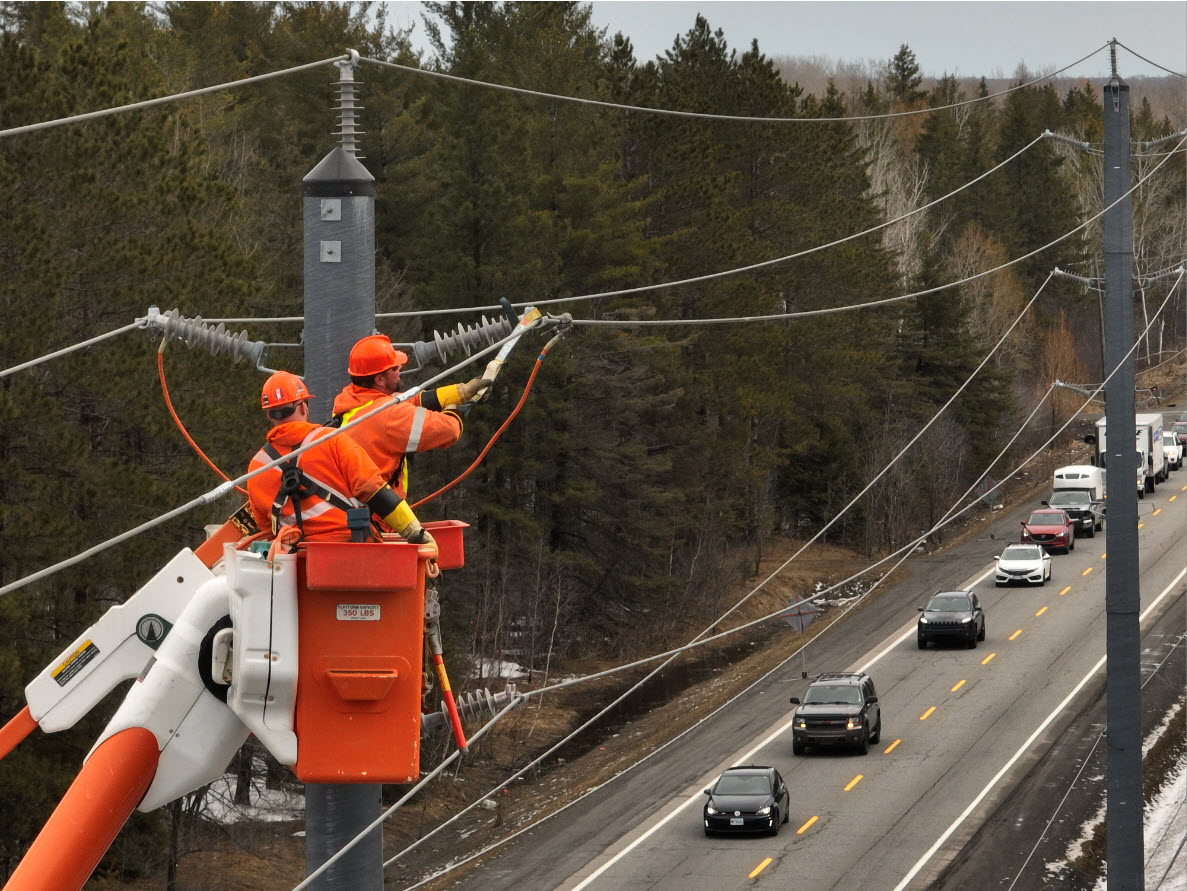While there are many advantages to living in a region like the Ottawa Valley, the geography of living in a valley can make us more susceptible to spring storms. An unexpected storm has the ability to disrupt our lives suddenly, and can take the shine off of living in such a beautiful region of the country.
The prolonged period of freezing rain that the capital region experienced on April 5, resulted in significant and damaging ice build-up on trees, wires and Hydro Ottawa equipment for days afterwards.
When a storm like this is on the horizon, Hydro Ottawa’s Control Centre is already forecasting possible impacts and preparing for the unpredictable. Here’s an inside look at what we do before, during and after a storm, including how we prioritize power restoration efforts.
Before the storm – Monitoring and prevention
Year round, our crews are involved in regular maintenance activities to make repairs and upgrades to the electricity grid. They will also consider trimming tree overgrowth as a preventative measure against high winds or thunderstorms.
Hydro Ottawa vigilantly observes weather conditions and stays on top of changing weather patterns so that we can alert customers about possible outages. In the case of a weather warning, we plan ahead by keeping our crews on standby so that if the power does go out, we can restore it as quickly and safely as possible. And if a weather event is imminent, we’ll send out a Weather Watch email, as well as share weather warning messages to our followers on Twitter and Facebook – another great reason to follow us.
Inside Hydro Ottawa, our Control Centre is working 24/7 to monitor potentially disruptive weather patterns which could result in power outages. In the event that a serious storm is imminent, field operators will be put on stand-by to respond to emergencies and to restore outages on a priority basis. During the recent ice storm, over 225 internal and external field resources were called up to repair damages across the city of Ottawa – the second highest use of resources in Hydro Ottawa’s history.
During a storm – Safety, assessments and restoration
When a major storm causes widespread outages across our service territory, our first job is to investigate the extent of the damage and to evaluate which resources are required before the power can be restored. Our electrical grid is integrated and complex so restoring power takes time, and depends on our ability to assess the problem and to create restoration plans which prioritize the safety of residents and our crew.
Hydro Ottawa then restores power on a priority basis. This sequence may look familiar: it’s similar to what the City of Ottawa and other municipalities use during snow removal:
Priority 1: Respond to public safety issues and emergencies
Priority 2: Fix critical electrical system infrastructure (ex: substations, main power lines)
Priority 3: Restore power to critical infrastructure and emergency services (i.e. hospitals, water & sewage treatment plants, schools)
Priority 4: Repair power lines that will restore power to the largest number of customers
Priority 5: Restore smaller neighbourhood clusters
Priority 6: Respond to individual homes and businesses that may have sustained damage to their electrical equipment
Public and personal safety are the first priority for our crews. Falling trees and branches, windy conditions, heavy fog, thunder and lightning, and treacherous icy roads can delay our crews’ efforts. In situations like this, our crews need to step down and focus on areas where their efforts can assist customers while not risking lives.
While we do our best to predict when power will be restored, estimated restoration times can change once crews get on site and assess the damage. Initial restoration times on our outage map are based on a number of factors: weather conditions, location of the outage, suspected severity of damage, past outages in the area, and more. Once crews are able to assess the damage and identify any potential safety issues that may impact restorations, we’ll update the estimated restoration time.
While infrastructure is being repaired and power is restored, Hydro Ottawa broadly communicates the status and safety details of outages, when it is known, to our customers, the broader public, the City of Ottawa, and the media. Our teams will be at work 24-7 until power is restored to all.
After the storm – Repairs and improvements
Every storm and outage presents an opportunity to learn and to build a stronger and more resilient electricity grid. Our teams track all relevant outage data, including when and why it happened, and how long it took to resolve the situation and make repairs. All of this information helps us to plan and prioritize upgrades to our electricity infrastructure.
While buried lines may seem like an obvious fix based on the recent number of downed wires from the April ice storm, the answer is much more complex. Making the switch to a full underground system would come at a hefty price tag because underground lines can be up to 11 times more expensive, and cost anywhere between $2 million and $4 million per kilometre.
We’re big believers in continuous improvement (and learning). Hydro Ottawa has emergency preparedness plans in place which are updated regularly. We also conduct emergency plan training under different scenarios so that we can be as storm-ready as possible. After every storm, we analyze the event and our teams’ efforts to restore power. Every extreme weather event is an opportunity to assess, to learn and to build back better. To learn more about our response and strategic priorities and improvements related to the May 2022 derecho, read our report here.
For more information and related topics, read our recently published blogs:

